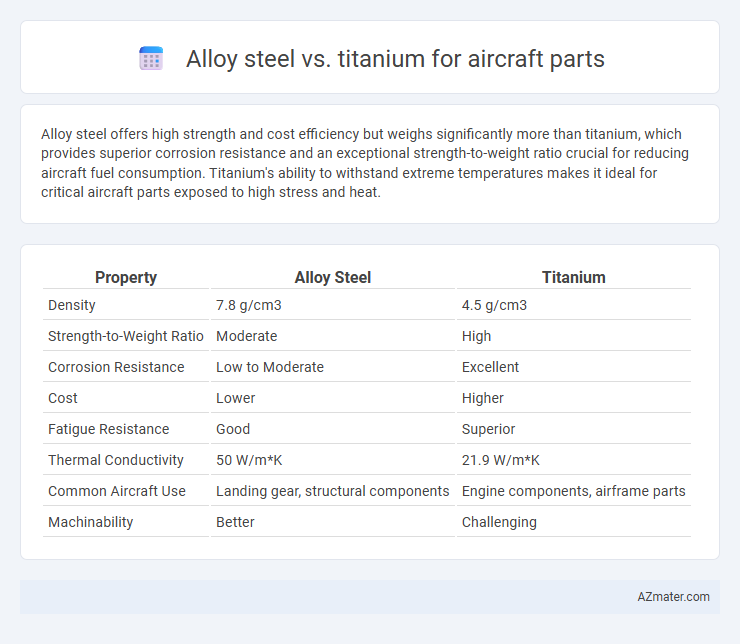Alloy steel offers high strength and cost efficiency but weighs significantly more than titanium, which provides superior corrosion resistance and an exceptional strength-to-weight ratio crucial for reducing aircraft fuel consumption. Titanium's ability to withstand extreme temperatures makes it ideal for critical aircraft parts exposed to high stress and heat.
Table of Comparison
| Property | Alloy Steel | Titanium |
|---|---|---|
| Density | 7.8 g/cm3 | 4.5 g/cm3 |
| Strength-to-Weight Ratio | Moderate | High |
| Corrosion Resistance | Low to Moderate | Excellent |
| Cost | Lower | Higher |
| Fatigue Resistance | Good | Superior |
| Thermal Conductivity | 50 W/m*K | 21.9 W/m*K |
| Common Aircraft Use | Landing gear, structural components | Engine components, airframe parts |
| Machinability | Better | Challenging |
Introduction to Alloy Steel and Titanium in Aerospace
Alloy steel and titanium are critical materials in aerospace engineering, each offering distinct advantages for aircraft parts. Alloy steel is known for its high strength, durability, and cost-effectiveness, making it suitable for structural components subjected to heavy loads and impact. Titanium combines exceptional strength-to-weight ratio, corrosion resistance, and heat tolerance, ideal for parts requiring lightweight yet robust performance in harsh aerospace environments.
Material Composition and Properties
Alloy steel used in aircraft parts typically contains carbon, manganese, chromium, and nickel, offering high tensile strength and excellent wear resistance crucial for structural components. Titanium, composed primarily of titanium with small amounts of aluminum and vanadium, boasts an exceptional strength-to-weight ratio and superior corrosion resistance, making it ideal for aerospace applications requiring lightweight durability. The high melting point and fatigue resistance of titanium provide advantages over alloy steel in performance-critical aircraft parts exposed to extreme environments.
Strength-to-Weight Ratio Comparison
Titanium exhibits a superior strength-to-weight ratio compared to most alloy steels, making it a preferred choice for critical aircraft components where weight reduction is essential without compromising structural integrity. Alloy steels offer higher absolute strength and toughness but at a significantly greater density, resulting in heavier parts that can reduce overall fuel efficiency. The exceptional fatigue resistance and corrosion resistance of titanium further enhance its performance in aerospace applications, optimizing both durability and weight savings.
Corrosion Resistance in Aircraft Environments
Titanium exhibits superior corrosion resistance compared to alloy steel in aircraft environments due to its ability to form a stable, protective oxide layer that withstands moisture, salt spray, and chemical exposure typical in aviation conditions. Alloy steel, while strong, is more susceptible to rust and stress corrosion cracking, requiring protective coatings and frequent maintenance to prevent degradation. The enhanced durability of titanium in corrosive environments significantly improves aircraft part longevity and reduces lifecycle costs.
Fatigue and Durability Performance
Alloy steel exhibits high fatigue strength and excellent durability, making it suitable for aircraft parts subject to cyclic loading and stress variations. Titanium offers superior corrosion resistance, a favorable strength-to-weight ratio, and exceptional fatigue resistance, enhancing overall aircraft performance and longevity. In aerospace applications, titanium's durability under extreme conditions often surpasses alloy steel, despite alloy steel's cost-effectiveness and machinability benefits.
Machinability and Manufacturing Considerations
Alloy steel offers superior machinability due to its balanced hardness and ductility, enabling faster cutting speeds and prolonged tool life in manufacturing aircraft parts. Titanium, while providing excellent strength-to-weight ratio and corrosion resistance, poses challenges in machining because of its tendency to gall and generate high cutting temperatures, necessitating specialized tooling and slower processes. Manufacturing aircraft components requires weighing alloy steel's ease of machinability against titanium's performance benefits and higher production complexity.
Cost Analysis: Alloy Steel vs Titanium
Titanium offers superior strength-to-weight ratio and corrosion resistance but comes with significantly higher raw material and processing costs compared to alloy steel. Alloy steel provides a more cost-effective alternative for aircraft parts requiring high strength and durability without the premium price of titanium. Lifecycle maintenance costs also favor titanium due to its enhanced corrosion resistance, but initial investment and machining expenses make alloy steel preferred in budget-sensitive applications.
Common Applications in Aircraft Components
Alloy steel is widely used in aircraft components requiring high tensile strength and fatigue resistance, such as landing gears, engine mounts, and structural frames. Titanium is favored for parts needing high strength-to-weight ratio and corrosion resistance, including jet engine components, airframe structures, and fasteners. The choice between alloy steel and titanium depends on factors like weight reduction, mechanical properties, and environmental exposure in aerospace engineering.
Maintenance and Lifecycle Performance
Alloy steel offers high strength and cost-effective maintenance with established repair techniques, making it suitable for aircraft parts requiring frequent inspection and quick turnaround. Titanium provides superior corrosion resistance and fatigue performance, reducing maintenance frequency and extending lifecycle duration, albeit with higher initial costs and specialized servicing needs. Lifecycle performance favors titanium for long-term durability, while alloy steel remains practical for components where routine maintenance and lower upfront investment are critical.
Future Trends in Aerospace Material Selection
Future trends in aerospace material selection emphasize the growing adoption of titanium due to its superior strength-to-weight ratio and exceptional corrosion resistance compared to traditional alloy steel. Advancements in titanium alloy processing and additive manufacturing are driving reduced production costs and enhanced component performance. Ongoing research targets optimizing the balance between weight reduction and durability to meet stringent fuel efficiency and environmental regulations in next-generation aircraft design.

Infographic: Alloy steel vs Titanium for Aircraft part
 azmater.com
azmater.com